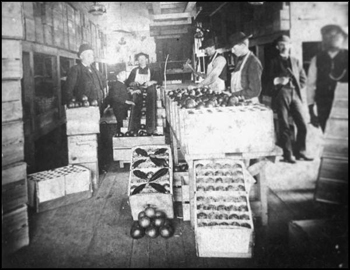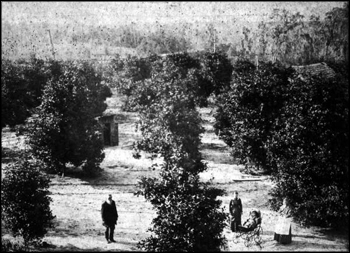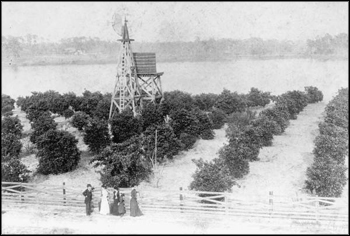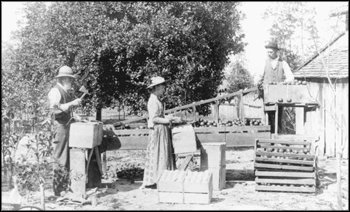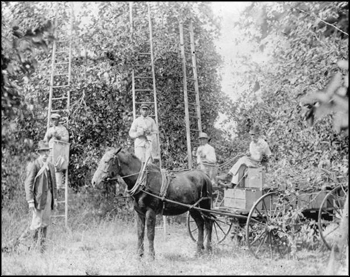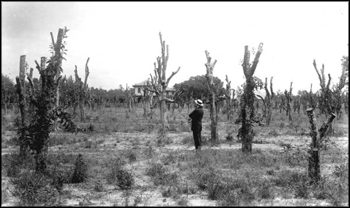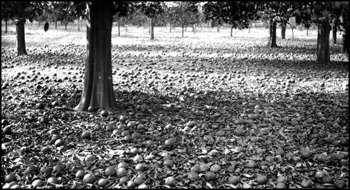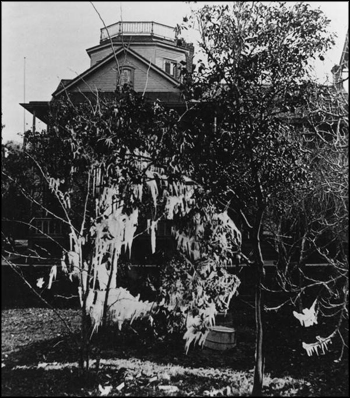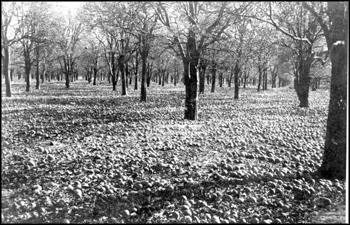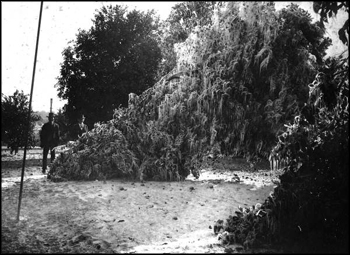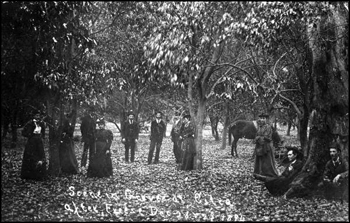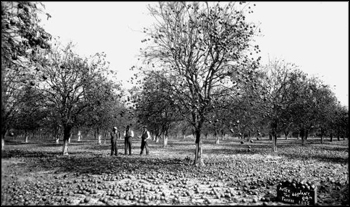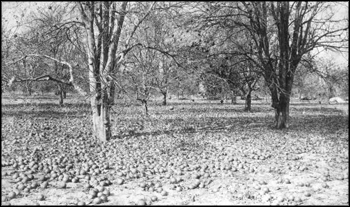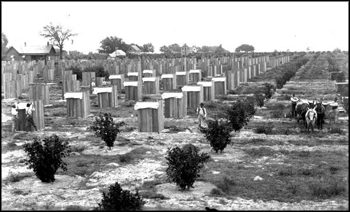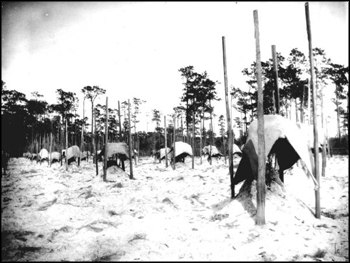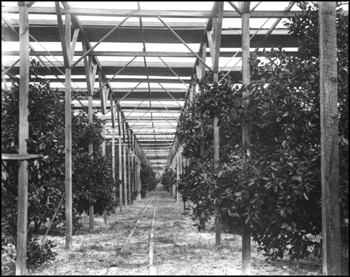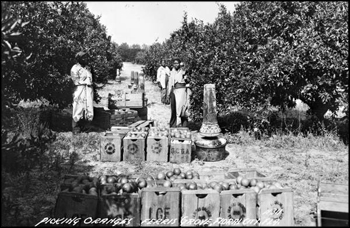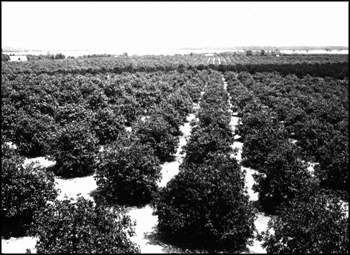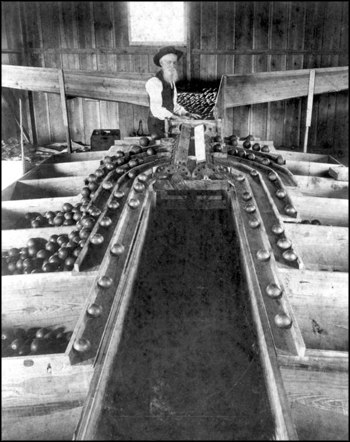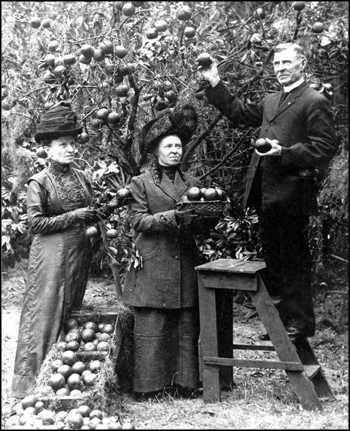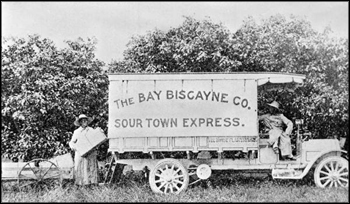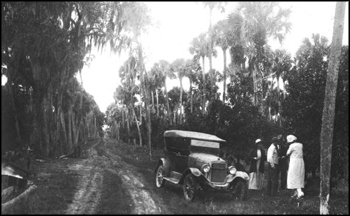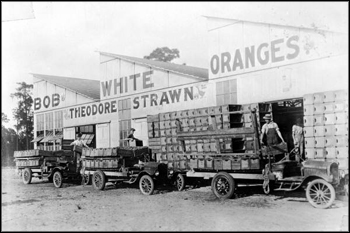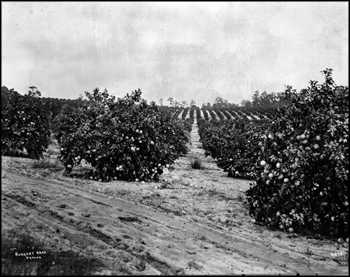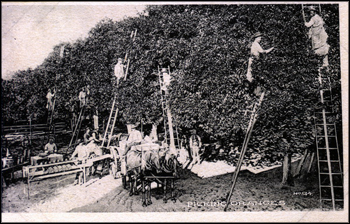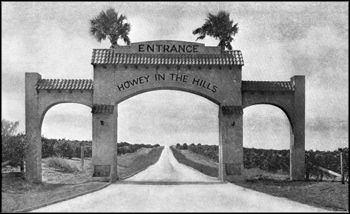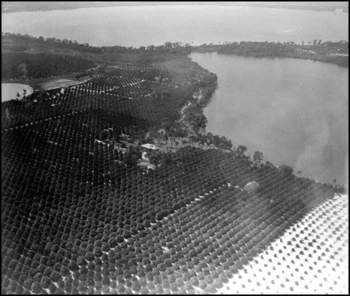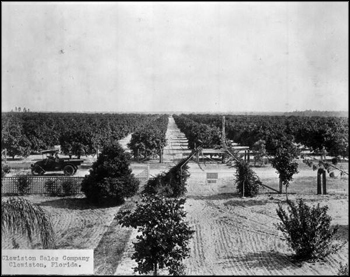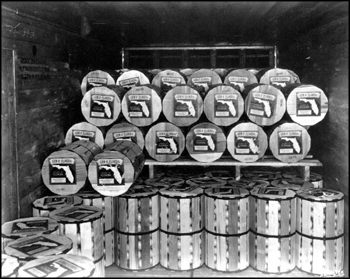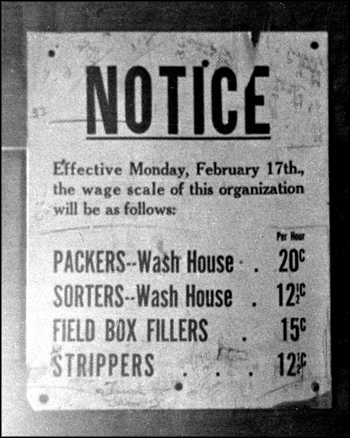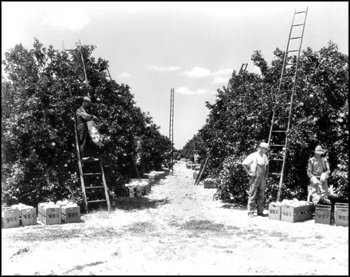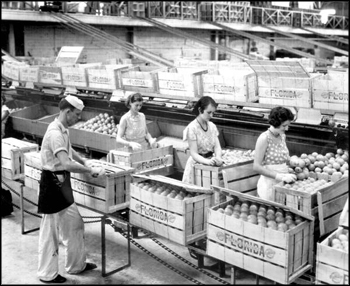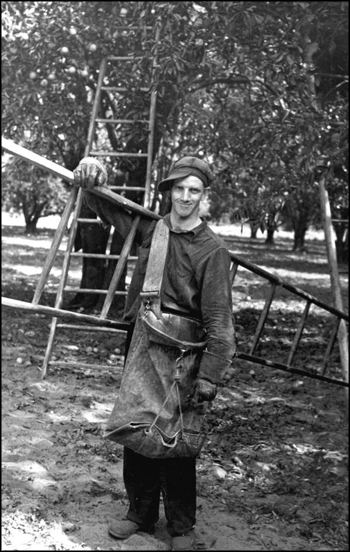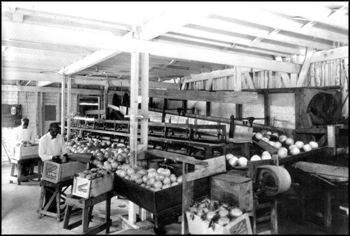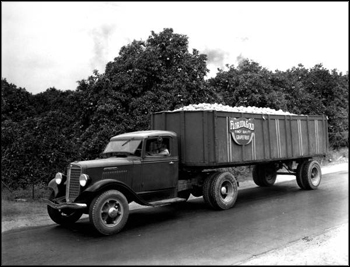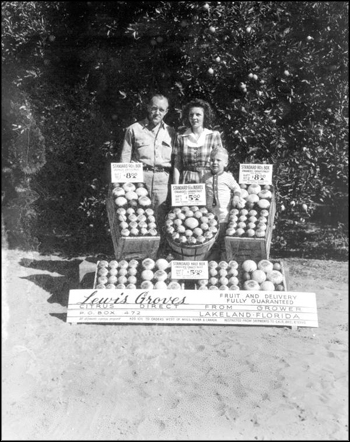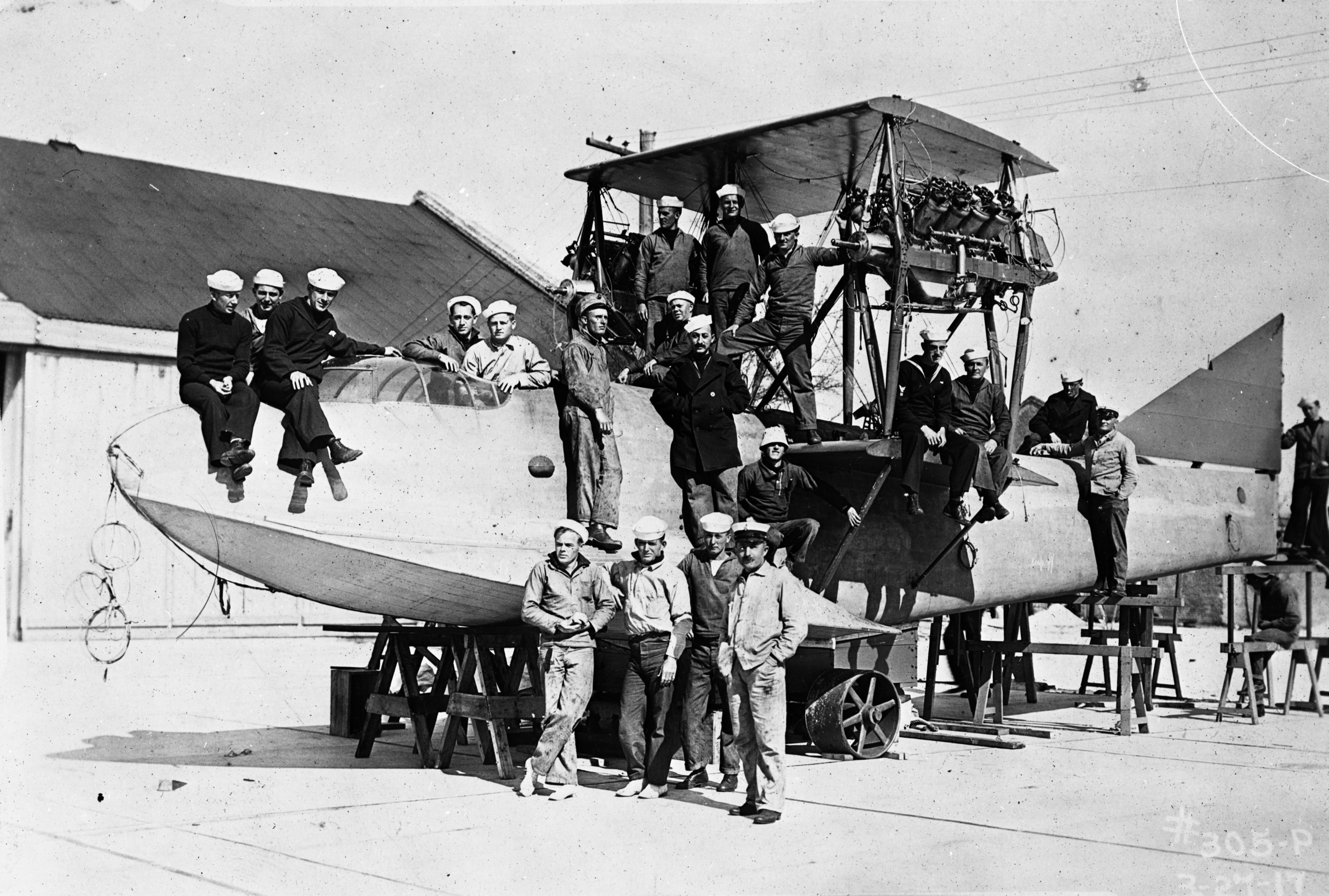Photo Exhibits
Photo exhibits spotlight various topics in Florida history, and are accompanied by brief text intended to place selected materials in historical context.
Bittersweet: The Rise and Fall of the Citrus Industry in Florida
The First Boom, the Great Freeze and Recovery
The expansion of railroads into southern Florida contributed to the growth of the citrus industry in the late 19th century. With the railroads came an increase in population and in acreage devoted to citrus cultivation. Boosters promoted Florida as a paradise on earth: the climate cured all aliments and the soil produced wealth with little effort. Citrus figured prominently into the selling of Florida as a retreat for yeoman farmers, tourists and invalids. Many settlers caught orange fever and assumed they could reap substantial profits in no time, while they and their groves basked effortlessly in the Florida sunshine.
Workers in C.S. Hasbrouck's packing house (1886)
Image number: RC08087
David S. Berkstresser and family at a Hawthorne orange grove: Hawthorne, Florida (between 1882 and 1890)
Image number: PR04175
General note: The photograph was taken 2 miles east of Hawthorne on the old Palatka Road. Pictured, left to right: David S. Berkstresser, his wife Elizabeth, their granddaughter Mary (born 8/6/1882), and Emma, wife of their son William H.
View of Lake Morton: Lakeland, Florida (ca. 1890)
Image number: FR0907
General note: Looking from Florida Avenue.
Sizing and packing oranges (ca. 1890)
Image number: RC04800
Picking fruit in John C. English's seedling grove: Alva, Florida (ca. 1890s)
Image number: RC08162
General note: Sampson English (left) was grove foreman for the Owanita Citrus Association.
Dreams of easy money in the citrus industry came to an end for many during the great freeze of 1894 and 1895. Earlier freeze events, such as one in 1886, signaled a warning of things to come. In December 1894 and then again in February 1895, temperatures plummeted throughout the state. Many growers saw their investments crumble as frozen limbs snapped and fruit fell to the ground. Before the great freeze, Florida produced five million boxes of citrus. Production would not reach the five million figure again for almost two decades following the winter of 1894-95. With the memory of devastating freezes fresh, growers devised various methods to help trees and fruit resist the cold.
Remains of an orange grove after a freeze: Caldwell, Florida (ca. 1880s)
Image number: RC02290
Fallen oranges in Major Foster's grove after the freeze: Manatee County, Florida (1886)
Image number: RC07108
Great freeze (1886)
Image number: RC05091
Damage to an orange grove because of cold: Bartow, Florida (1894)
Image number: FR0323
General note: Streaty Parker's orange grove is pictured. Many groves in the state looked like this after one of two freezes that occurred in the state on December 27, 1894. The second, which froze many of the trees as well, began with a blizzard on February 7, 1895, which was followed by temperatures in the low 20's for three successive nights.
Scene in grove at Orange City Waterworks after freeze of December 28 and 29: Orange City, Florida (1894)
Image number: PR01607
General note: Trees were sprayed to protect them from a freeze. They sprouted out in the morning but were all killed in the Feb. 8, 1895 freeze.
Scene in grove at Citra after freeze of December 28 and 29: Citra, Florida (1894)
Image number: PR01606
Citrus grove after freeze (1895)
Image number: RC02364
Rockledge grove of Alfred Trafford after the freeze: Rockledge, Florida (1895)
Image number: PR01608
Wooden shelters built to protect citrus trees from a freeze (ca. 1890s)
Image number: RC02408
Interior view of Stetson's slat shack protecting his citrus grove: DeLand, Florida (ca. 1900)
Image number: CC205
Picking oranges in Ferris Grove: Floral City, Florida (early 1900s)
Image number: N028976
The citrus industry again moved southward after the 1894-95 freezes. Groves that survived the great freeze gained widespread notoriety. This period of recovery gave way to a second citrus boom, lasting until the 1970s. The town of Keystone City was renamed Frostproof after its trees weathered the freeze. Dummett's grove on Merritt Island emerged untouched once again, further bolstering the reputation of Indian River citrus. Growers around the state sought to use the Indian River label in order to associate their product with Dummett's legacy. In the 1930s and 1940s, state and federal authorities defined an "Indian River" area and pursued retailers who peddled fraudulent fruits.
Citrus grove: Winter Haven, Florida (ca. early 1900s)
Image number: LC410
Orange sizer invented by James B. Crum (1905)
Image number: RC05454
General note: The device, invented by 78 year old James B. Crum, was made in 3 sizes to sell at $35, $40 and $45. The estimated capacity was 40-60 crates of fruit per hour. It was operated by a light pedal.
Sargent family picking oranges (1912)
Image number: RC06022
Shipping fruit from Miami on the Sour Town Express: Miami, Florida (ca. 1910s)
Image number: N029011
Tourists picking oranges in a roadside grove (ca. 1910s)
Image number: PR01612
Theodore Strawn's packing house for Bob White oranges: De Leon Springs, Florida (ca. 1910)
Image number: N034710
Citrus grove: Highlands County, Florida (ca. 1920s)
Image number: N028981
Picking oranges (ca. 1920s)
Image number: PC0520
Orange grove: Clewiston, Florida (ca. 1920s)
Image number: N028987
Crated citrus: Auburndale, Florida (ca. 1930s)
Image number: FR0013
Winter Haven Citrus Growers Association employees working in grove: Winter Haven, Florida (1931)
Image number: FR0694
Employees at the Florence Citrus Growers Association packing boxes: Winter Haven, Florida (1934)
Image number: FR0732
Interior of Winter Haven Citrus Company packing house: Winter Haven, Florida (ca. mid 1900s)
Image number: FR0137
Florida Gold truck: Polk County, Florida (ca. 1940s)
Image number: FR0220
Lewis Groves: Lakeland, Florida (ca. 1940s)
Image number: FR0236

 Listen: The World Program
Listen: The World Program